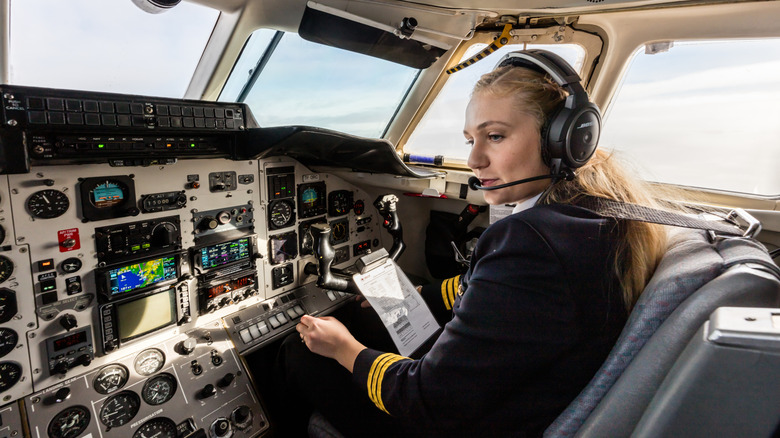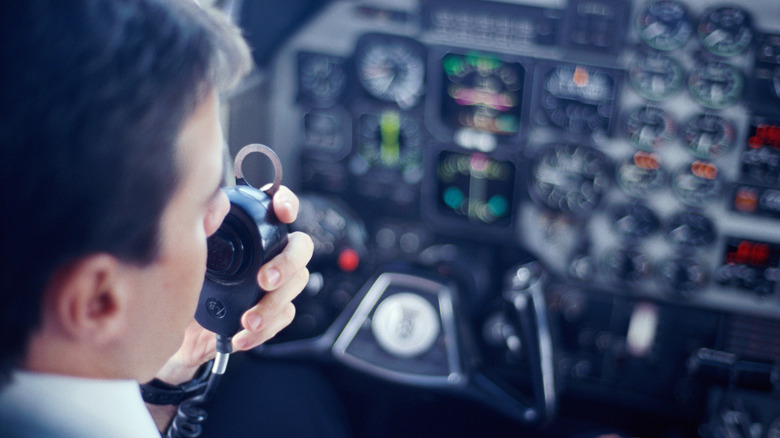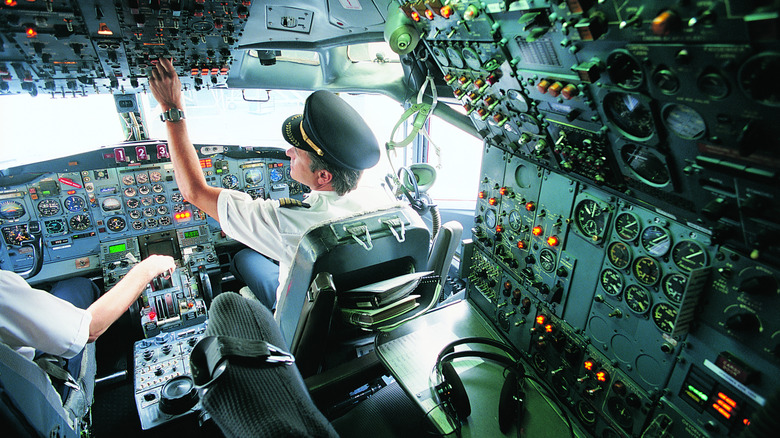Why Do Pilots Say 'Tree' And 'Niner' Instead Of Three And Nine?
Any profession that requires an extensive use of radio communication is going to have its fair share of quirks. We all know things like having to say "Roger" to confirm to that you have heard the other person's message over the radio, but the lingo can be even more complicated than that. If you are a trucker that uses CB radio, you have to remember a litany of codes that start with the number 10 to report various things that are occurring on the road, from reporting traffic jams to requesting police presence to saying you're taking a bathroom break. Some of the stranger bits of lingo come from airplane pilots, and among their unique quirks is that they have their own way of saying the alphabet and numbers.
Knowing that you say "Charlie" for the letter C or "Tango" for T is a pretty well-known fact, but the numbers are a bit stranger. If you are communicating on the radio while in the air, you will not say the number "three" or "nine." Instead, you will say "tree" or "niner." Other modifications need to be made as well, such as four being said as "fow-er" and five as "fife." This seems like it would cause needless confusion, but there are a couple of very good reasons as to why these pronunciation changes are made for these numbers. The first has to do with the radio technology itself, and the other concerns the international community, communicating these numbers to those who do not normally speak English. Let's look back at the history to see how these particular aviation phonetics came to be.
Codified for earlier radios
Radios have been around since the late 19th Century, but it isn't like the technology has always been immaculate since the very first day it was produced. You had to deal with poor speaker quality, interrupted radio signals, and a whole host of other things that could make radio communication incredibly difficult. When radio operators were gradually coming up with ways to communicate with radios, it became incredibly important to be able to convey crucial information through all the challenges that a radio frequency can present. This is partially why the International Civil Aviation Organization — or ICAO — needed to have numbers and letters that could only be construed as those numbers and letters through poor reception and crackly speakers.
The ICAO officially codified this numbering structure all the way back in 1956. So, despite speakers and radio frequencies improving in the decades since, pilots still need to go back to these official pronunciations. It may seem outdated at a first glance, but just because the technology has improved does not mean that it is faultless. You are still going to have times when reception is of a lower quality, but you would still be able to distinguish someone saying "niner" instead of the one-syllable "nine" that could be muffled. The ICAO phonetic alphabet has certainly become an "If it ain't broke, don't fix it" system, and it has proven itself to be not broken.
Pronunciation needs to be universal
Importantly, this is not just a phonetic alphabet used by English speakers. This is a standardization to be used all around the world, if its endorsement by both the ICAO and NATO wasn't a clear indication of that. If you are a speaker of French, Spanish, Japanese, or any other language, you need to adhere to these pronunciations while in the air as well. Flying an airplane is an incredibly dangerous task, and everyone who is in the air and on the ground needs to be on the same page. By utilizing this phonetic alphabet, pilots can bypass language barriers and are able to account for a variety of different accents that can be heard over the radio.
For example, some accents utilize a non-rhotic R, meaning that they don't pronounce that letter in certain words that contain it. Because of this, words that mean very different things could sound very similar, especially through a speaker. This is how something like "fife" is created for the number five. Even though five has no R, the word "fire" does, and for non-rhotic speakers, that R gets flattened out. All of a sudden, "five" and "fire" sound the same, and saying a number is a lot different from reporting a fire.
Then there are instances of accounting for other non-English words. For instance, you have the Sanskrit word "sri," and with certain accents, that could very easily sound like "three." Changing the pronunciation to "tree" eliminates any of that confusion. The IAOC phonetic alphabet addresses technological and cultural concerns, keeping everybody safe.


